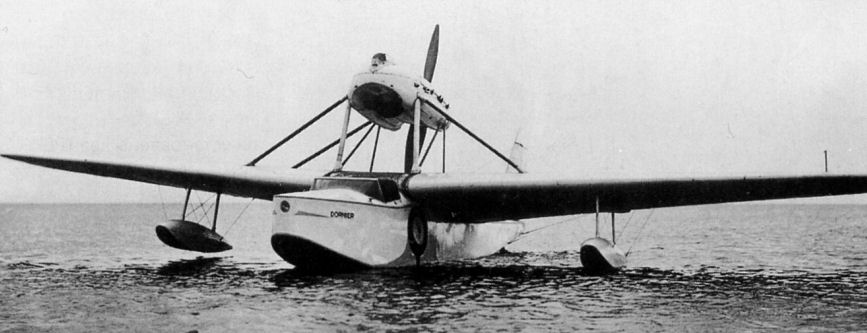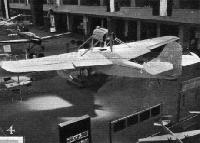
Варианты
- Dornier - Do.A Libelle / Spatz - 1921 - Германия
- Dornier - Do.12 Libelle III - 1932 - Германия
Flight, October 1932
The New Dornier "Libelle"
ONE of the first small flying boats to be produced was the "Libelle" (Dragonfly), designed and built by the Dornier Company, of Friedrichshafen, on Lake Constance. That machine never attained any real popularity, although a few specimens did quite good work. The reason probably was that it was rather "before its time."
Dr. Dornier has recently brought out a modern version of the "Libelle," which we show in the set of photographs on this page. The new "Libelle" is, it will be seen, a "pusher," which, in itself, is a great improvement on the original machine, in which the propeller tips passed uncomfortably close in front of the pilot's face. Furthermore, the new "Libelle" is an amphibian, which is, perhaps, an even greater improvement, the more so as the undercarriage is not merely retractable in the sense of being capable of being lifted clear of the water, but is retractable in the sense of disappearing into the structure and offering no extra head resistance when folded. The extra weight of a retractable undercarriage for amphibians is inescapable, but at least Dr. Dornier has followed the logical course of ensuring that parasite drag shall not be added.
The photographs show that the machine is, with undercarriage raised, a very "clean" design, and this fact should help a good deal to make up for the extra weight entailed by the undercarriage. The hull is, it will be observed, of the flat-bottomed type, a type which has never found much favour with British designers, but which has the advantage, firstly, of cheap construction and, secondly, of facilitating the take-off. Dr. Dornier probably reasons that a flying boat of this size cannot in any case be expected to be really seaworthy, and that therefore the vee bottom, which acts as a very good landing shock absorber, is not essential. Certainly there are advantages as well as drawbacks in the flat-bottom hull. For example, if, when the machine is beached or standing about in a shed, it is desired to relieve the undercarriage of the load, and also to reduce overall height, either for garaging or for working on the engine, etc., the machine will be stable when standing on its step, and will require no propping up.
The hull of the "Libelle" is of duralumin construction, and is divided into five watertight compartments. In the forward part of the cabin there are two seats side by side. Both occupants are equipped with controls, but if dual control is not wanted, one set can be easily removed. Entrance to the cabin is from the forward deck, through a hinged door for each seat. Behind the cabin proper is a seat for a third occupant. This is reached through a trap door in the wing, and is provided with a folding wind screen.
The monoplane wing is of the semi-cantilever type, with spars and ribs of drawn duralumin strip. The nose portion of the wing is covered with sheet duralumin, the rest of the wing with doped fabric.
The tail organs have spars of welded steel tube and ribs of duralumin. The covering is fabric. A trimming gear is provided for the tailplane.
By having the engine mounted on struts above the wing, the use of different power plants to suit customers' requirements becomes an easy matter. The actual machine illustrated has an Argus As.10, but such engines as the Napier E.97 or the Armstrong-Siddeley "Lynx" can also be fitted. The Argus engine is rated at 220 b.h.p., which power is developed at 2,100 r.p.m. It is of the direct-drive type, and drives a pusher airscrew. The cowling is stated to be so arranged that cooling is satisfactory not only during flight, but also when the machine is taxied for prolonged periods on the water. Some idea of how this is accomplished can be gathered from photograph No. 4 on the next page.
The fuel is carried in two wing tanks, one on each side. Each tank has a capacity of 100 litres (22 gallons), and the mounting is such that the tanks can easily be removed through the top covering of the wing. An oil tank of 14 litres (3 gallons) capacity is mounted in the engine housing. Petrol is supplied to the engine by two petrol pumps of the diaphragm type.
No performance figures are available at present, but the new Dornier "Libelle" has a tare weight of 811 kg. (1,780 lb.) and a disposable load of 389 kg. (855 lb.), giving a gross weight of 1 200 kg. (2,635 lb.). The overall length of the machine is 8.9 m. (29 ft. 2 in.), the wing span 13 m. (42 ft. 7 in.), and the wing area 25 m2 (269 sq. ft.). The height when the machine is standing on its wheels and the airscrew is running is 4.1 m. (13 ft. 5 in.), and with airscrew stopped 3.2 m. (10 ft. 6 in.).
- Flight, October 1932
The New Dornier "Libelle"
Фотографии
-
Мировая Авиация 111
У плоскодонного корпуса Libelle по бортам имелись спонсоны аэродинамического профиля, обеспечивающие устойчивость самолета на воде.
На фото - Do.12 Libelle III -
Flight 1932-10 / Flight
THE NEW "LIBELLE": In the upper photograph, showing the machine at rest on the water, the port wheel of the undercarriage can be seen retracted into the side of the hull. The middle photograph shows the machine being hoisted into the water, with the wheels lowered. In the lower picture one obtains a good idea of the absence of extra drag when the undercarriage is raised.
-
Flight 1932-10 / Flight
A rather fine view of the new Dornier "Libelle" amphibian. Note the openings in the engine cowling through which the propeller draws the air to assist in cooling. What the effect is on the airscrew efficiency is not known.
- Фотографии


